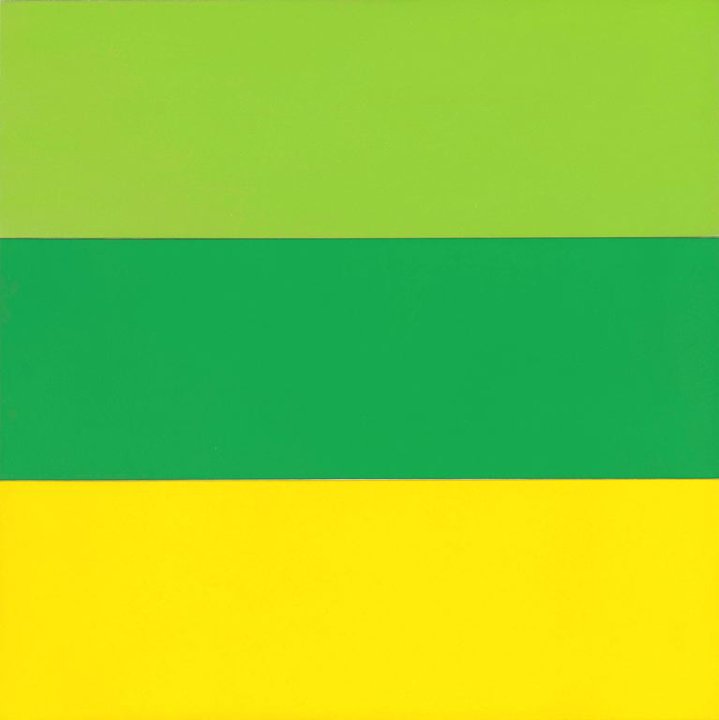Ellsworth Kelly, born in 1923, was an American artist who was active first in
France and, later, in the U.S. until his death in 2015. He is best known for his straightforward,
highly abstracted paintings consisting of solid colors and multiple canvases.
Kelly’s work is moving because of its vivid simplicity and large scale—his
paintings easily envelops the viewer. Taking a step towards the painting,
reading the title, and taking two steps back changes the viewer’s experience of
the work from abstract to concrete, but makes the experience no less immersive.
The work itself has not changed, but by learning what subject Kelly had translated
to create the work, a new layer of significance is added, and the work is
transformed in the eye of the viewer. I first had this experience with Spectrum II (1966-1967, above) at the St.
Louis Art Museum, paintings are both transformative for the viewer and an
experience based on the transformations that occur while viewing, and reflect
Kelly’s creative philosophy of existence and art, of a visual world that is
just waiting to be transformed.
In Ellsworth
Kelly: Catalogue Raisonné of Paintings, Reliefs, and Sculpture, Volume One,
1940–1953, compiled by Yve Alain Bois, Kelly explained, “Everywhere I
looked, everything I saw became something to be made, and it had to be made
exactly as it was.” Kelly’s partner, Jack Shear, further explained Kelly’s
creative outlook: “If you turn off the mind and look only with the eyes ultimately everything becomes abstract."
The painting above is a
work by Ellsworth Kelly I’ve visited many times at the Art Institute of
Chicago. The painting is nearly
four feet by four feet, a perfect square. The colors are solid, vibrant, and
matte. As displayed at the Art Institute, it’s on a white wall, with a small
plaque near the bottom right corner, too small to read if viewed from far
enough away to appreciate the painting as a whole work. You approach the
painting from across the room, drawn to it by the bright, well-matched colors,
symmetry, and overall starkness. Maybe the brightness of the yellow is what
caught your eye, or the striking quality of the darker green between the two
lighter colors, or the wonder of the geometric perfection of the canvas—is it
one or three pieces, you wonder? (When you step closer, you see it’s made of
three joined canvas panels—one per color.) Nevertheless, the scale and color of
Train Landscape has drawn you over,
and you stand at a distance, marveling at the technical perfection. You project
your own experiences and interpretations onto it—when I saw it, I thought, “wow,
that’s my favorite shade of yellow… it reminds me of a summer day at the farm,
looking at the sunflowers.”
After contemplating the
painting in the context of your own experience, you step forward to read the
plaque at the bottom right. “Ellsworth Kelly, American, 1923-2015. Train Landscape, 1953. Oil on canvas;
three joined panels. 11.8 x 111.8 cm (44 x 44 in.) Collection of the artist,
73.2004,” the plaque notes, and explains that this was Kelly’s view from of the
countryside through the window of a train, with the colors from fields of corn
and soybeans blurring together thanks to the speed at which he was traveling. You
step back again, look at the panels through your newfound lens of a speeding
train window, see the fields of corn and soybeans rushing past, and move on to
the next work of art. Whether or not you realized it, your viewing of Train Landscape was a
reverse-engineering of Kelly’s creative process in making it.
Kelly’s process involved
seeing the world through eyes unclouded by extraneous meaning and translating
what he saw as reality into a reality others could see as well. By seeing the
colors and shapes of his work first, and what they are second, we see Kelly’s
reality in the purest possible sense.
For more on Ellsworth Kelly's process and life, as well as interviews, please see his interview with The Guardian shortly before his death, and "'Exactly As it Was': Ellsworth Kelly's Basic Training" by Tim Keane. Several works are also on display at The Art Institute of Chicago, including Train Landscape.


No comments:
Post a Comment
Note: Only a member of this blog may post a comment.